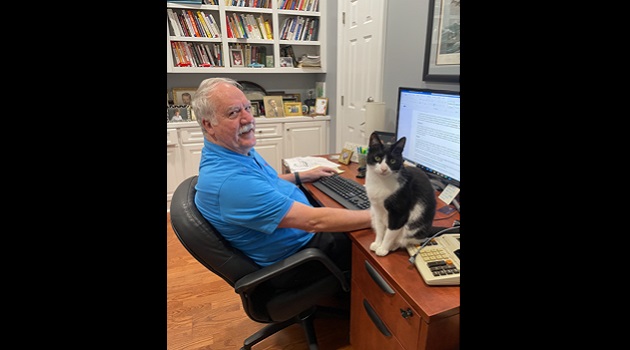By Mike DuBose with Dr. David Hurst, DVM
We recently shared the physical and mental positive benefits of having pets. We now turn our attention to a sad part of our series—euthanasia—which in Greek means “Good Death.” Deciding to euthanize our beloved pets—even with a poor quality of life due to disease or an injury—is one of the hardest choices animal lovers will ever have to face. Even more dreadful is deciding—“When?” Many owners ask themselves, “Was it really time?” In most cases, we have done all we can to give our pets happy lives. Yet, we still wonder if their loyalty was violated by “putting them down” too early or too late. This uncertainty makes it even harder to cope with devastating losses. Many of us look back with guilt and regret for waiting too long. Euthanasia is a serious human trauma but waiting for the end to occur is the worst part of the horrific trip. Many animal lovers find themselves going to the Vet multiple times before making the final decision. Unfortunately, our animals cannot communicate with us when they are suffering, but their declining behaviors and poor physical well-being often will tell you “It’s time.” Though better to make the decision a week early than a day late, we struggle with the thought of “How can we go on living without our pet?”
Your Vet may initially suggest a hospice program that can provide extra time for you and your family to say your “Loving Goodbyes.” They can prescribe pain and other medicines to make them comfortable in their final days. Sometimes, a pet’s end-of-life treatments can be managed but for other animals, time has run out, especially with tragedies or major diseases.
Eventually, when a decision is made to end your pet’s life, with input from your Vet, the following are some suggestions to consider: Ask that your appointment be the last one of the day. Inquire if your Vet will come to your home and the costs. Dr. Hurst noted, “There are mobile veterinarians who provide private, in-home care, including palliative support and euthanasia (Estimated $300).”
When making an appointment, think carefully in advance how you want your animal’s remains cared for. Some pet parents take their animals home after the procedure and spend time with them. Afterwards, if government restrictions permit, they bury their pets on their property. Others plan formal burials in pet cemeteries. If you decide on a home burial, the Vet will place your loved one into a box to take home with you. If cremation is your choice, ask the Vet ahead of time for you to select a special ash container since there are options which will have your pet’s name on it. Others who cremate their animals spread their ashes in special places or keep them home. Vets can recommend other options.
You don’t want to end your animal’s life and try to make all these decisions immediately before or after the procedure while in the waiting rooms. You cannot donate your pet to science. However, you can request a professional autopsy for approximately $300 through your Vet if the death is suspicious.
Decide if you and family members want to be present during the euthanasia procedure. No one is comfortable with death. Vets report 50% of animal lovers don’t desire to be present, yet many family members later regret not being there in the end. Other Vets note that your pet will be frightened and a family member should consider being present. Remember that your pet has been a significant part of your life for a very long time. You want to look them into their eyes before their procedure and say, “It’s OK to leave us. We love and will miss you!”
If you decide to end your animal’s life at the Vet’s office, we suggest waiting in your car with your pet until the last minute. Ask the receptionist to call when it’s time and inquire if there is a side door you can enter and exit versus going out into the general lobby. Be prepared that when you enter the office, grieving, along with your pet, there may be laughter and chatter from other animal owners. The patients don’t realize that you are about to end your best friend’s life. You want to enter the waiting room quickly. Ensure to pay your Vet bill before the procedure versus painfully standing in line crying afterward.
Be prepared for there to be crying from you and the staff. They love pets just as much as you do. Your Vet will explain the euthanasia process. Usually, they’ll take your animal to the back area to insert an infusion site. Initially, your pet will receive a sedative. Once they are relaxed, a final solution will be injected and within seconds, they will drift into what appears to be a peaceful, deep sleep. Afterward, the Vet will check the pet’s heart to verify that they have passed. Our recommendation is not to rush to exit after the procedure and leave your beloved pet. Spend some quality time holding and caressing them.
The Bottom Line: You have travelled a very painful road helping your beloved pet to end their suffering. Our next article will share our thoughts and research on how to recover from one of life’s most painful events. There’s hope!
Dr. Hurst is a licensed veterinarian with Friarsgate Animal Hospital in Columbia, SC. He is a graduate of Newberry College and the University of Georgia’s College of Veterinary Medicine.
The DuBose family’s purpose is to “Create Opportunities to Improve Lives.” Mike is a staff member with USC’s graduate school. In 1987, he founded his family of companies and eventually wrote the book “The Art of Building Great Businesses.” Visit his nonprofit website www.mikedubose.com for free access to his books and 100+ published articles, including business, travel, and personal topics, in addition to health research with Surb Guram, MD.



